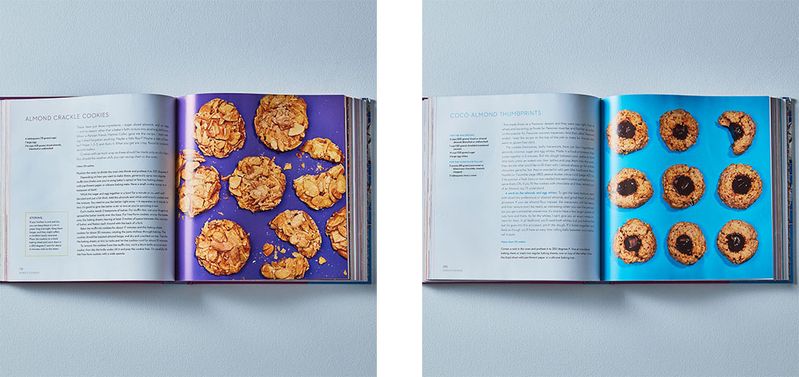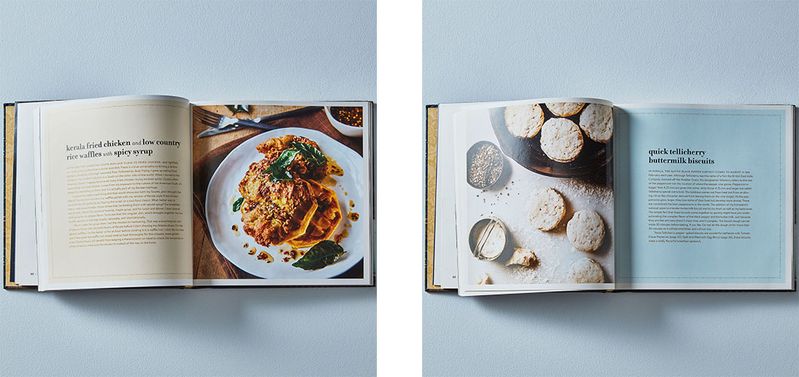When two seemingly unrelated, unconnected, and disparately-focused cookbooks, Dorie’s Cookies by Dorie Greenspan and My Two Souths by Asha Gomez with Martha Foose, arrived in my Brooklyn kitchen, they pulled at the separate but intertwined heartstrings of a younger me, who had long ago been cookie-obsessed and finding a new home in the American South.
Since I was seven, I’ve been reading cookbooks. I’m not sure whether other refugee children dealt with their displacement this way, but I sure did: I wanted to make the “exotic” dishes of my new land, specifically North Carolina circa 1975, and in particular I wanted to make cookies. I was so enamored with these All-American divots of dough that my mother called me Cookie Monster. At least, I think that’s why. The emphasis was more on the “Cookie” and less on the “Monster,” right, Mom?
I sent away for free cookbooks, mostly glorified promotional pamphlets, along with the 25 or 50 cents for “shipping and handling.” I checked out cookbooks from the local library, which was an inextricably sad act because I knew that a parting of ways was inevitable.
In the ensuing four decades, my cookbook collection has grown to include hundreds of volumes. Some were well-intentioned if poorly chosen gifts; many I’ve rescued from cardboard boxes marked “free” because I can’t bear to see books abandoned (they’re like puppies to me); and lots that I’ve purchased, mostly from thrift stores or used bookshops. I prefer the niche, ode-to-a-single-ingredient cookbooks; those that are historical snapshots of how a community once ate; or, best of all, memoirs, biographies, or art manifestos in disguise.
Dorie’s Cookies and My Two Souths are welcomed additions, and I’m keeping them, side by side, on the bookshelves in my kitchen. The majority of my cookbooks are relegated elsewhere, never to be anointed by grease stains or blessed by the aromas of day-to-day cooking.
When I was seven, I would have swooned if I’d been given a tome like Dorie’s Cookies. Actually, I almost did faint when I first saw it but unfortunately not out of delight: The look of it made me instantly nauseous. I don’t mean this metaphorically. I mean my stomach dropped.
The front cover is a close-up of a single, perfectly round, otherwise luscious-looking World Peace Cookie, which is a dark chocolate sablé, photographed against a minimal purple backdrop. It’s a hue that was probably last used for the lettering of grape-flavored chewing gum and produced in me both vertigo and repulsion. The same visual schematic is repeated throughout the book: Each recipe is accompanied by a photograph of a lone cookie or sometimes of multiple cookies (occasionally a wire rack or crumpled parchment paper is included) taken against a plain field of purples, pinks, blues, or yellows, in shades which are uncannily both pulsating and depressing.

I begin with this critique because I know how unfair it is to the author. According to Greenspan’s introduction, she spent three years testing and winnowing over 300 recipes down to the stellar, “bake it again and again” ones. It wasn’t her job also to oversee the design of her cookbook, but for me a cookbook’s look and feel is akin to the décor of a restaurant. I may eat there despite the décor, but it will determine whether I’ll linger and whether I’ll return.
While I didn’t enjoy lingering within the pages of Dorie’s Cookies, I did eagerly try out six of her recipes, four sweet and two savory cookies.
My husband chose the first one, Snowy-Topped Brownie Drops, because they looked exactly like the ones made by his late grandmother from Minnesota. It was the perfect entrée. As Greenspan wrote in her introduction, “cookies are memories, and I often bake to make memories real again.” The recipe was simple, straightforward, and no-fuss. Alas, so were the resulting cookies. My husband took the first bite and affirmed that they tasted like his grandmother’s. I took a bite and found them one-note, a tad too sweet, and basically a chewy brownie enrobed in confectioners' sugar. I asked my husband if he would want to have these cookies again. He shrugged, which is his polite “no.”
The next two recipes I chose because I adore almonds: Swedish Visiting Cake Bars and Moroccan Semolina and Almond Cookies. Of the two, I will certainly make the latter again. As the recipe’s headnote promised, the combination of semolina and almond flour produced an elegant cookie with a pleasing “sandy” texture. The recipe included one of Greenspan’s simple yet genius techniques: Instead of stirring grated citrus zests into the batter, use your fingertips to rub the zests together with the sugar. The resulting boost in citrus flavor was near magical. In this recipe, the zest of one lemon tasted as if I’d added two or three.
I headed next to the “Cocktail Cookies” chapter and baked Cheddar-Seed Wafers and Parmesan Galettes. I brought both batches to a party that night and wished that I’d stayed at home with all of them instead. The Galettes, made from a four-ingredient, slice-and-bake dough, were flaky, melt-in-your-mouth cheese crackers (that’s what Southerners would call them). The recipe offered two ways to bake: freestanding on a baking sheet or in a greased muffin tin. I tried both, and the latter method produced the superior result, adding a delectable, slightly more golden layer of crumb to the bottom and the sides of the galettes.
The Cheddar-Seed Wafers required that I take out my rolling pin, which is something I assiduously avoid, but here Greenspan again offered up one of her signature tips: Roll the pieces of dough in between two sheets of parchment paper. The result was paper-thin, delicate, and gorgeously crisp.
Before I left Dorie’s Cookies, I had to give My Newest Chocolate Chip Cookies a try. In the headnote, the author writes, “Recipes for chocolate chip cookies are like scarves—you’re always happy to have a new one.” I agree with her when it comes to scarves, but I’ve been making the same chocolate chip cookie recipe since college. My tried-and-true recipe offers what I appreciate most about this American classic: a yielding chewiness; an irregular, undulating shape that reminds me of cooled lava; a pronounced brown sugar flavor, and resolutely distinct chips.
Greenspan’s recipe called for hand chopping the chocolate. She suggested that the fine bits and flakes, created in the process, enhanced the flavor of the dough. To the contrary, the chocolate dust altered the flavor of the dough, making it vaguely chocolate and this, for me, decreased the pleasure of the companionable contrast between the brown sugar butter cookie and the chocolate chips.
Of the 170 recipes featured in Dorie’s Cookies, there are frankly ones that I’ve no interest in trying, not that they don’t all look tempting. It’s about the time commitment and fussiness involved with some of them. I’ll never try her recipe for Macarons (two pages long, not including the various fillings), for instance. This is a bias of mine: When I think of cookies, I revert back to the little girl, and I want a recipe that has the ease and breeziness that I’ve long associated with these sweet treats. I’m childlike when it comes to cookies. The good news is that Dorie’s Cookies includes recipes that fall along the full spectrum of maturity. Her instructions are clear, with just enough details, and she suggests flavor variations and ingredient substitutions in the “Playing Around” sidebar of many of her recipes, which encourages and allows for the improvisation and frolicking that comes with the cookie genre. I frankly haven’t thought this much about cookies in a long time, so a nod of thanks to Dorie’s Cookies for bringing the cookie-obsessed one back.
Given my own two Souths—my birthplace in South Vietnam and childhood in North Carolina—I was, of course, intrigued by My Two Souths by Asha Gomez with Martha Foose, a collection of recipes that celebrates chef Gomez’s birthplace (and her home for the first twelve years of her life) in Kerala, a southern state of India, and the vibrant city that she has called home since 2000, Atlanta, Georgia. In her charming introduction, Gomez divulges that she began her life in Atlanta not as a chef but as the owner of a posh ayurvedic spa. Her dream profession was to be an aesthetician. Along the way, she began to share her Keralan home cooking with her clients, and her culinary journey continued from there.
To think of these recipes as promoting yet another wild, gimmicky form of culinary mashup would be doing Gomez a great disservice because her dishes are smarter, wiser, and more from the heart than that. She doesn’t combine disparate flavors and ingredients just to see what would happen or because it has never been done before. As they say in the American South, she has sussed them out before welcoming them into her dishes, where they behave like equally dear friends of hers, who just happened to have grown up thousands of miles apart.

Because I can’t pass up chicken and waffles in any form, I began with Kerala Fried Chicken and Low Country Rice Waffles with Spicy Syrup, one composed dish with three components and recipes, each, as it turned out, worthy of a repeat, stand-alone performance. The chicken thighs (boneless and skinless) were marinated overnight in a heady blend of buttermilk, fresh cilantro, and mint, Serrano chile, and garlic (10 extravagant cloves); dredged in flour and salt; and fried crisp, the inside tender, moist, and luscious. Next time I make them, I’ll keep the skin and the bone because it makes me a bit sad when I can’t pick up a piece of chicken and gnaw at it.
While I could have intuited from the ingredient list alone that the Kerala Fried Chicken would be delicious, I didn’t anticipate how much I would adore the Low Country Rice Waffles, a variant of a traditional buttermilk waffle with the addition of rice flour, cooked jasmine rice, and crushed cardamom. While my ancient, home waffle maker steamed rather than crisped (popping the finished waffles into the toaster for about a minute helped), the fragrant jasmine rice and crushed cardamom shined through here. Perfect paired with the fried chicken, they were also a pleasure all on their own.
The third component was the spicy syrup, which I have to admit I almost skipped because it did have the slightest whiff of gimmick: maple syrup or the more Southern cane syrup infused overnight with toasted cumin and coriander seeds and red pepper flakes. Transformative and bedazzled was what the spicy syrup did to Gomez’s already toothsome rendition of chicken and waffles. The heat from the red pepper and the depth and warmth from the whole, toasted spices added welcoming notes to the syrup and to the dish. I’ve been thinking of other foods to drizzle it on. I’m also thinking it would be an excellent sweetener for a bourbon-based cocktail. I love it when food not only tastes great but also makes me think and anticipate.
I also cannot pass up savory hand pies, which are what samosas became in Gomez’s kitchen, so next I made the recipes for Puff Pastry Samosa Pockets, a batch with the Sirloin and Sweet Pea Filling and another with the Curry Chicken Filling. Her Samosa Pockets were baked and not fried, wrapped in a frozen, all-butter puff pastry dough, and were the size of small burritos. I made the mistake of serving them as the appetizers for a dinner party, and my guests stuffed themselves on those instead of the mains.
Before I left My Two Souths, I unfairly—or so I thought—tried one of Gomez’s cookie recipes. I should have doubled the amount for her Smoky Hazelnut Chocolate Cookies, which made ten (I ended up with twelve) generously sized cookies. I’m staring at the last one right now. I’m already in mourning.
Gomez’s palate and penchant for spices led to the surprising, brilliant addition of smoked sweet paprika to a simple Nutella-enriched cookie dough. I had baked them on the same day as a batch of My Newest Chocolate Chip Cookies from Dorie’s Cookies. The next morning my husband took half of My Newest to work with him to share—he really does this to save me from myself—and left all of the Smoky Hazelnut at home. My otherwise generous spouse was hoarding! His vote for this head-to-head was clear. So was mine.
My only reservations about My Two Souths are the occasional, oddly worded instructions. If you’re an experienced home cook or chef, you’ll spot them and adjust accordingly. If you’re reliant solely upon this cookbook to steer you, then there will be moments when you’ll find yourself needlessly lost. For example, the list of ingredients for Low Country Rice Waffles includes “6 to 8 cardamom pods, crushed.” I’ve been cooking from Indian cookbooks long enough to understand what Gomez wants me to do: lightly crush the pods, remove the fibrous outside and discard, and coarsely crush the little seeds found inside. At the beginning of My Two Souths, she does include an introduction to spices and other regional ingredients, including an entry for cardamom. Unfortunately, there is nothing in that entry that clearly tells you what I just did about removing and discarding the fibrous outside of the pods. (There are, of course, instances in cooking when you’ll leave the pods whole, but certainly that couldn’t have been the case for the waffle recipe.) For me, such hiccups didn’t disqualify this thought-provoking, border-joining, delectable cookbook from the top spot. Though I would understand if you read this and thought, “Wow, I would have had a batch of waffles with extra fiber in them! No thank you.”
This semifinal round of the Piglet goes to My Two Souths by Asha Gomez with Martha Foose.



57 Comments
I found for myself that I am definitely going to make cookies, more than in the past, with this book. It is a masterwork.
As always, what appeals to the tester lends a bias. She feels some of the cookie recipes are too complicated, but whipping up fried chicken, waffles and a sauce is not?
I'm sorry the decision went this way.
On the other hand, My Two Souths should normally appeal to my love of Indian food and learning new and unusual-to-me flavor combinations. However, I was very underwhelmed after eating at her now-closed Atlanta restaurant, Cardamom Hill (the meal was surprisingly one-note and lacking in depth of flavor) – thus, I was not so enthused about picking up her cookbook either. But Ms. Truong’s review of her chicken and waffles truly made my mouth water! I’m really curious to see other ways Asha Gomez plays up traditional southern staples with unique flavor combinations. I’m adding My Two Souths (and thanks to Piglet, Samarkand!) to my Amazon cart!
I also really loved Ms. Truong’s writing. I looked up her website and bio and I can’t wait to read more of her work! I loved how she described herself: “When she is not writing, which is most of the time, she cooks and takes naps. She lacks many basic life skills such as knowing how to drive a car, and ride a bicycle, and has only recently learned how to read a map. She has been known to walk long distances, especially if there is a very good bakery located at the end of that walk.” This. Is. ME!
However, as a professional chef and design geek, I want to express my enthusiasm for the stunning look of Dorie's book. (Needless to say, her recipes, as always, are superb.) I felt that the photography and layout does a great job of highlighting each cookie. We've already seen a multitude of books with cookies shown piled high on grandma's china plates, on crisped parchment with chocolate smears, or featured cooling on vintage racks, so it's really nice to see a fresh and different approach. Chacun à son goût!... but claiming design-induced nausea seemed a bit hyperbolic in the midst of an otherwise solid bit of writing.
I don't find it hyperbolic at all, and this would not be the only instance of an abhorrent (to my sensitivities) design choice preventing me from purchasing something, alas. Though I f you are not one troubled by certain senses ever becoming overwhelmed, I understand it can be hard to imagine it could be so for others.
Can you suggest a brand please? Lime curd thumbprints.
Maybe this one would do ok
Thank you for baking cookies from My Two South's. I enjoy making recipes from both of these authors.
I agree with another commenter, that it hurt to read the harsh criticism of Dorie Greenspan's cookbook design. I'm not a fan of those bright monotones either (to me, cookies are more "vintage china"), but describing the induced nausea seemed excessive. I can never forget that a real human being will read these reviews. Nonetheless, the reviewer seems to have done a fair review of the recipes, and I appreciated her praise of the lemon zest technique as a counter to the strong criticism of the book's design.